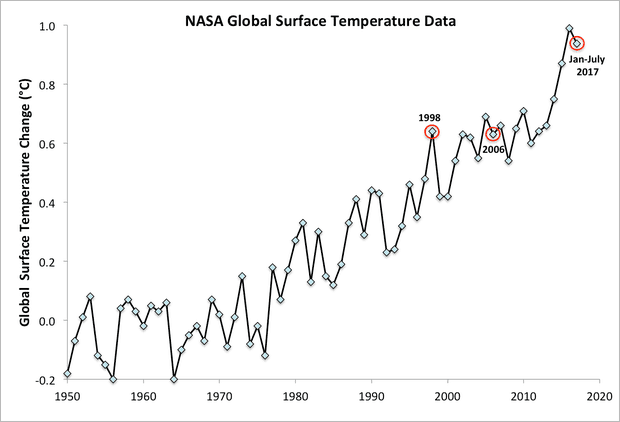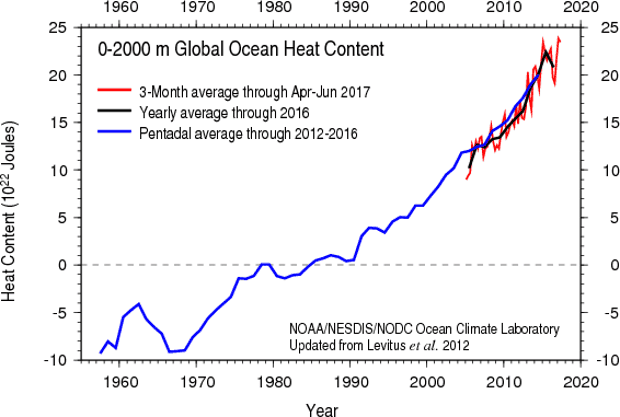
With the first six months of 2017 in the books, average global surface temperatures so far this year are 0.94°C above the 1950–1980 average, according to NASA. That makes 2017 the second-hottest first six calendar months on record, behind only 2016.
That’s remarkable because 2017 hasn’t had the warming influence of an El Niño event. El Niños bring warm ocean water to the surface, temporarily causing average global surface temperatures to rise. 2016 – including the first six months of the year – was influenced by one of the strongest El Niño events on record.
For a long time one of the favorite climate denier myths involved claiming that we hadn’t seen any global surface warming since 1998. That myth has fallen by the wayside since 2014, 2015, and 2016 each broke the global surface temperature records previously set in 2010 and 2005 (which were also both hotter than 1998). Yet the myth persisted for years because 1998 was anomalously hot due to the monster El Niño event that year, which meant that global temperatures weren’t much hotter than 1998 until 2014 to today.
Now the first six months of 2017 have been 0.3°C hotter than 1998, despite the former having no El Niño warming influence and the latter being amplified by a monster El Niño. In 1998, there was also more solar energy reaching Earth than there has been in 2017.

Total solar irradiance data (red) and linear trend (orange) since 1950 from the Laboratory for Atmospheric and Space Physics Solar Irradiance Data Center at the University of Colorado. Illustration: Dana Nuccitelli
In terms of El Niño and solar temperature influences, 2017 thus far has been most similar to 2006, but 2017 has been 0.3°C hotter than 2006 as well.

Global average surface temperature data from the NASA Goddard Institute for Space Studies. Illustration: Dana Nuccitelli
In a recent Senate committee hearing, Trump’s Department of Energy Secretary Rick Perry said that he didn’t believe human carbon pollution is the primary control knob for the Earth’s climate (it is; hence the title of this NASA paper published in the journal Science in 2010), but instead placed most of the blame on “naturally occurring events – the warming and the cooling of our ocean waters.”
That’s a simple hypothesis to test. If global surface temperatures were rising due to an exchange of heat from ocean cycles, then as Perry noted, ocean temperatures would be alternatively warming and cooling. When oceans transferred heat to the surface, their temperatures would cool, and vice-versa. That’s simply not happening – measurements show that the oceans have steadily built up heat:

Global ocean heat content data for 0–2000 meters. Illustration: National Oceanic & Atmospheric Administration, National Centers for Environmental Information
Instead, every component of the Earth’s climate is warming. Surface air temperatures, lower atmospheric temperatures, ocean temperatures, and sea levels are rising as ice around the globe melts. That’s a key signature not of an internal Earth cycle, but of an external influence – either an increase in incoming energy from the sun, or a decrease in outgoing energy, for example due to an increase in the heat-trapping greenhouse effect. And as we’ve established, there’s actually been a slight decrease in incoming solar energy.
The culprit is quite clearly human carbon pollution. That’s how the first six months of 2017, despite lacking solar or El Niño ocean warming, can be hotter than 1998, and 2006, and every year before 2016.
Posted by dana1981 on Monday, 31 July, 2017
 |
The Skeptical Science website by Skeptical Science is licensed under a Creative Commons Attribution 3.0 Unported License. |